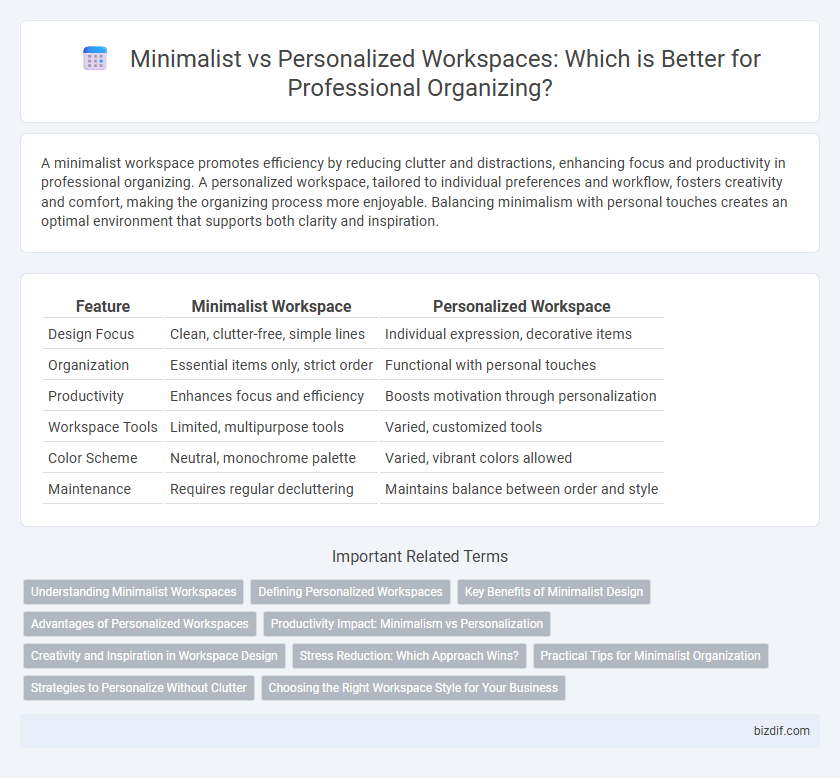A minimalist workspace promotes efficiency by reducing clutter and distractions, enhancing focus and productivity in professional organizing. A personalized workspace, tailored to individual preferences and workflow, fosters creativity and comfort, making the organizing process more enjoyable. Balancing minimalism with personal touches creates an optimal environment that supports both clarity and inspiration.
Table of Comparison
| Feature | Minimalist Workspace | Personalized Workspace |
|---|---|---|
| Design Focus | Clean, clutter-free, simple lines | Individual expression, decorative items |
| Organization | Essential items only, strict order | Functional with personal touches |
| Productivity | Enhances focus and efficiency | Boosts motivation through personalization |
| Workspace Tools | Limited, multipurpose tools | Varied, customized tools |
| Color Scheme | Neutral, monochrome palette | Varied, vibrant colors allowed |
| Maintenance | Requires regular decluttering | Maintains balance between order and style |
Understanding Minimalist Workspaces
Minimalist workspaces prioritize simplicity and functionality, emphasizing clean surfaces, essential tools, and clutter-free zones to enhance focus and productivity. This approach reduces distractions by limiting visual noise and optimizing storage solutions, allowing individuals to engage deeply with tasks. Understanding minimalist workspaces involves recognizing the balance between necessary items and open space, which supports mental clarity and efficient workflow.
Defining Personalized Workspaces
Personalized workspaces are designed to reflect individual preferences, incorporating personal items, color schemes, and ergonomic setups that enhance comfort and productivity. Unlike minimalist workspaces that emphasize simplicity and clutter-free zones, personalized workspaces balance functionality with elements that inspire creativity and motivation. This approach caters to user-specific needs, fostering a work environment that supports both efficiency and personal expression.
Key Benefits of Minimalist Design
Minimalist workspace design enhances productivity by reducing visual clutter and promoting focus through clean surfaces and streamlined organization. This approach fosters mental clarity and efficient task management by prioritizing essential tools and eliminating distractions. Minimalist workspaces also facilitate easier maintenance and quicker cleaning, contributing to a consistently organized and professional environment.
Advantages of Personalized Workspaces
Personalized workspaces enhance productivity by reflecting individual preferences and work habits, fostering comfort and motivation. Custom elements such as favorite colors, ergonomic furniture, and meaningful decor create an environment that reduces stress and supports creativity. Unlike minimalist setups, personalized spaces adapt flexibly to diverse tasks, improving overall efficiency and job satisfaction.
Productivity Impact: Minimalism vs Personalization
Minimalist workspaces enhance productivity by reducing distractions and promoting focus through clean, clutter-free environments optimized for essential tasks. Personalized workspaces boost motivation and creative engagement by incorporating individual preferences, fostering comfort and connection to one's work. Balancing minimalism and personalization can optimize productivity by merging clarity with personal inspiration.
Creativity and Inspiration in Workspace Design
A minimalist workspace reduces visual clutter, promoting focus and mental clarity that can enhance creative problem-solving and idea generation. In contrast, a personalized workspace incorporates meaningful objects and creative decor that inspire originality and emotional connection, fueling motivation. Balancing minimalism with personalized elements tailors the environment to individual cognitive preferences, optimizing both creativity and inspiration.
Stress Reduction: Which Approach Wins?
Minimalist workspaces reduce stress by eliminating clutter, promoting focus through clean lines and simple design that minimizes distractions. Personalized workspaces, on the other hand, incorporate meaningful items and colors that enhance comfort and emotional well-being, contributing to a stress-free environment tailored to individual preferences. Research shows that combining minimalist principles with selective personalization offers optimal stress reduction by balancing order with personal significance.
Practical Tips for Minimalist Organization
Create a minimalist workspace by decluttering surfaces and keeping only essential items within easy reach, enhancing focus and productivity. Utilize storage solutions like drawer organizers and cable management systems to maintain a clean, streamlined environment that reduces visual distractions. Prioritize multi-functional furniture and neutral color schemes to foster an efficient, calming atmosphere conducive to work.
Strategies to Personalize Without Clutter
Maximize productivity by integrating essential personal touches in a minimalist workspace through curated desk accessories, subtle artwork, and functional storage solutions that maintain visual clarity. Utilize multi-purpose items and digital tools for customization while preventing excess physical objects. Prioritize open surfaces and declutter regularly to balance personalization with an efficient, distraction-free environment.
Choosing the Right Workspace Style for Your Business
Selecting the right workspace style for your business depends on productivity goals and brand identity. A minimalist workspace emphasizes simplicity, reducing clutter to enhance focus and efficiency, ideal for businesses prioritizing clean aesthetics and streamlined workflows. In contrast, a personalized workspace incorporates individual touches and customized elements, fostering creativity and employee engagement, making it suitable for companies aiming to reflect unique culture and encourage innovation.
Minimalist workspace vs Personalized workspace Infographic

 bizdif.com
bizdif.com